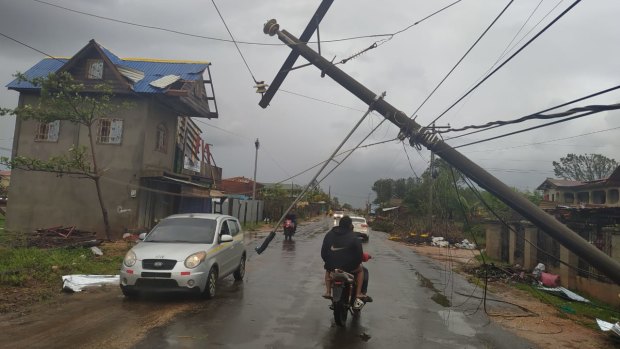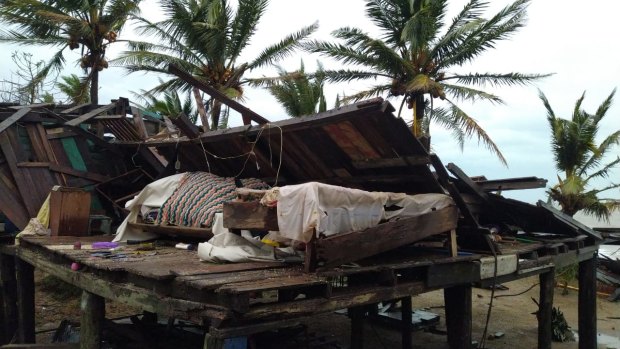- World
- Central America
- Extreme weather
This was published 4 years ago
Hurricane Iota's devastation comes into focus in storm-weary Nicaragua
By Carlos Herrera
Macizo de Peñas Blancas, Nicaragua: The devastation caused by hurricane Iota has become clearer as images emerged showing piles of wind-tossed lumber that used to be homes and concrete walls that were pounded into pieces by the second category-four storm to blast Nicaragua’s Caribbean coast in two weeks.
The official death toll stood at six, as reported by Vice-President and first lady Rosario Murillo. But that number was rising as authorities surveyed the damage and communications were restored. The victims were spread across the country, swept away by swollen rivers or buried in landslides.

A man in Puerto Cabezas, Nicaragua, rides his motorbike along a road damaged by Hurricane Iota.Credit: Getty Images
Rescuers searched at the site of a landslide in northern Nicaragua, where the local government confirmed four deaths and neighbours spoke of at least 16.
A short video from the nation's emergency management agency showed a massive bowl-shaped mountainside shrouded in clouds that collapsed. Police blocked media access to the site on the Macizo de Peñas Blancas, a mountain in Matagalpa province, about 130 kilometres north of Managua.
Pedro Haslam, the Matagalpa head of the ruling Sandinista Front party, told local Channel 4 television that he could confirm four deaths, four survivors and 15 missing in the landslide.
Rolando José Alvarez, the Roman Catholic bishop of Matagalpa, said via Twitter that priests were being sent to the area.
In the coastal city of Bilwi, a distraught Filimon Wilfred, 72, said Iota had destroyed his family's five houses leaving its 18 members homeless.

A severely damaged house is seen next to the coast in Puerto Cabezas, Nicaragua. Credit: Getty Images
“The hurricane came, it destroyed my house, my daughter’s house. It destroyed five houses in total," Wilfred said. "Where am I going to live?”
Iota arrived on Monday evening, Nicaragua time, with winds of 250km/h, hitting nearly the same location as hurricane Eta two weeks earlier. By early Wednesday, Iota had dissipated over El Salvador, but the storm's torrential rains remained a threat. Parts of neighbouring Honduras were still under water from Eta.
The storm's centre passed just south of Tegucigalpa, the mountainous capital of Honduras, where residents of low-lying, flood-prone areas were evacuated, as were residents of hillside neighbourhoods vulnerable to landslides.
Along Honduras’ remote eastern coast, people fled their homes as waters rose.
“What affected us most here was the flooding," said Teonela Paisano Wood, mayor of the Honduran town of Brus Laguna. “We are in danger if it keeps raining.”
Mirna Wood, vice president of the Miskito ethnic group in Honduras’ far eastern Gracias a Dios region, was in Tegucigalpa collecting donations for her community ravaged by Eta when Iota hit.
Some 40,000 people in the area had moved to shelters, but others remained stranded near the border with Nicaragua. Some were rescued by Nicaraguan authorities, she said.
“We are facing an incredible emergency,” Wood said. “There is no food. There is no water.”
Panama reported that one person was killed and another missing in its western Indigenous autonomous Ngabe Bugle area near the border with Costa Rica.
Earlier this month, Eta caused more than 130 deaths as it triggered flash floods and mudslides in parts of Central America and Mexico. The storm also left tens of thousands homeless in Honduras, which reported 74 deaths and nearly 57,000 people in shelters, mostly in the north.
Before hitting Nicaragua, Iota blew over the tiny Colombian island of Providencia, where Colombian President Ivan Duque said one person was killed and 98 per cent of the island's infrastructure was “affected”.
Iota was the 30th named storm of this year’s historically busy Atlantic hurricane season. It also developed later in the season than any other category-five storm on record, topping a November 8, 1932, Cuba hurricane, said Colorado State University hurricane researcher Phil Klotzbach.
The hurricane season officially ends on November 30.
AP